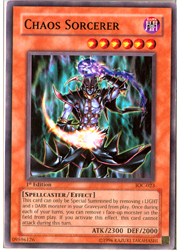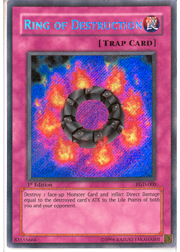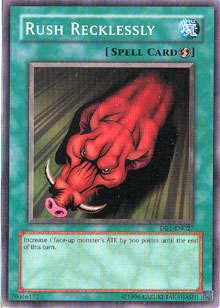So the new Advanced list is finally here, and we’re less than two weeks away from a brand new format! What impact is the list going to have, and what might have been some of the thought processes that went into its creation? I’m going to share my insight with you, and draw some conclusions about the impact the list is going to have.
Let’s look at some of the changes this new format is going to bring about, starting with the one we’ve all been waiting for!
The Invasion of Chaos Is Over!
It’s finally finished. After more than two years, the last remnants of the “remove a Light and Dark” mechanic are gone, swept clean off the Advanced format table. Now, when you’re building a deck you won’t need to feel bad every time you include a monster that doesn’t carry the Light or Dark Attribute.
 The elimination of Chaos Sorcerer from the global metagame is just one of several changes that are going to make skill more of a factor come September. Expect monsters like Silpheed, Gigantes, and Fenrir to see more play. More than that, the decks that support and include those monsters—all of which are centered around the themed use of particular attributes—will actually be viable. Playing such a deck will no longer feel like an immediate handicap. The floodgates are open, and creative duelists are going to be charging through them to see what they can find in a format filled with possibilities.
The elimination of Chaos Sorcerer from the global metagame is just one of several changes that are going to make skill more of a factor come September. Expect monsters like Silpheed, Gigantes, and Fenrir to see more play. More than that, the decks that support and include those monsters—all of which are centered around the themed use of particular attributes—will actually be viable. Playing such a deck will no longer feel like an immediate handicap. The floodgates are open, and creative duelists are going to be charging through them to see what they can find in a format filled with possibilities.
Less Topdecking
On one hand, luck and fate are a part of the Yu-Gi-Oh! TCG. Odds are good that some of your favorite memories revolve around drawing that one card you needed and pulling out the impossible win. But on the other, losing to a topdecked power card always stings. Snatch Steal not only punished players willing to commit to the field and summon a big monster, it gave an immediate shift in momentum with essentially no drawbacks. The fact that the stolen monster could be tributed to remove the drawback completely was a swift kick below the belt after the fact.
Spirit Reaper is another killer topdeck that we’ll no longer have to worry about. Played well, and taken control of the game? You won’t have to worry that your opponent might draw into Reaper, set it, and hide behind it for turns on end while you sit and wait for an Enemy Controller. Expect to see different defensive plans that take a bit more thought, as well as the return of Don Zaloog. Spirit Reaper is, of course, still there if you plan well enough to use him. Last Will for Reaper? Still viable. Zombie decks packing Pyramid Turtle? It’s perfectly searchable there, too, and Mystic Tomato can still grab it. But a turn 2 opening with Cyber Dragon and Reaper is now a lot harder to pull off, and Reaper is no longer a reliable late game out when your back’s against the wall.
The third topdeck that’s been toned down from the current format is Magician of Faith. Sure, it’s not an instant victory like Snatch Steal often was, and it’s not an invincible wall like Reaper, but a lot of games would often come down to a player topdecking Magician of Faith, reusing Graceful Charity, and winning. Again, if you want to search out Magician of Faith with Apprentice Magician you can do so, but in order to reliably generate an edge from the use of Faith you’re going to need to spend a bit more time planning your deck.
The Yu-Gi-Oh! TCG’s best luck-driven topdecks are now severely hindered. Chaos Sorcerer, Reaper, Snatch Steal, and Magician of Faith will no longer be central cards to the game. In fact, the only groan-worthy topdeck that’s left is Cyber-Stein. And things are going to be a little different for that guy.
The Amazing Exploding Cyber-Stein!
Deciding what to do with Stein must have been a difficult decision for the game’s handlers. On one hand, dedicated OTK builds of Cyber-Stein take thought, skill, and the guts to commit to a strategy that can go hideously wrong. Duelists like Igor Kharin and Cesar Gonzales deserve high praise for their intelligent deck building, as well as their courage and on-table prowess. Decks like theirs provide interesting variety at tournaments, and aren’t the ones that a format change aims to eliminate.
At the same time, the inclusion of one random Cyber-Stein in a totally unrelated deck can be downright obnoxious. You can’t side deck against it, because rotating in three Waboku and two Kuriboh cards against one card that your opponent might never draw is foolish. At the same time, it was difficult to play aggressively and separate the “Random Stein Duelist” from his or her precious life points, since the top strategies in the current format were often slow to get off the ground.
 Enter Ring of Destruction. Now, a duelist packing one copy of Cyber-Stein will need to clear out his or her opponent’s back row before bringing down a Cyber End Dragon or Cyber Twin. Otherwise, he or she runs the risk of losing the fusion monster, and the game, to Ring’s vicious effect. One false step with Stein will often mean game, something that wasn’t true in the last format. In addition, because Stein will make Ring worthy of inclusion in just about anything, you’ll often see both duelists knocked below 5000 life points mere turns into a duel. That makes Stein a dead draw from that point out, and an even riskier proposition in the long term.
Enter Ring of Destruction. Now, a duelist packing one copy of Cyber-Stein will need to clear out his or her opponent’s back row before bringing down a Cyber End Dragon or Cyber Twin. Otherwise, he or she runs the risk of losing the fusion monster, and the game, to Ring’s vicious effect. One false step with Stein will often mean game, something that wasn’t true in the last format. In addition, because Stein will make Ring worthy of inclusion in just about anything, you’ll often see both duelists knocked below 5000 life points mere turns into a duel. That makes Stein a dead draw from that point out, and an even riskier proposition in the long term.
As the central card for a gutsy strategy, Cyber-Stein is left practically untouched. But as a lame shortcut to victory it’s a lot harder to use.
Ding Dong, The Witch Is Dead!
You know, if you’d asked me about the one card I wanted to see forbidden, I’m not sure that Chaos Sorcerer would’ve been my immediate, clear-cut response. I wanted to see Tsukuyomi take a dirt nap bad. It served three purposes, all of which were relatively counterintuitive to what the game was trying to accomplish.
First up on my mind and yours, was Tsukuyomi’s power to create really stupid loops of effects in conjunction with cards like Dekoichi the Battlechanted Locomotive, Magical Merchant, and Magician of Faith. It slowed down tournament Top 8s, immediately changed the face of a duel, and generally created boring situations. It was a dull way to win, and while protecting a loop took some degree of skill, starting one was usually just an issue of dumb luck.
Second, as a defensive play Tsukuyomi punished the aggressive player and rewarded the conservative one who managed to fail in creating a Tsuku loop. “Oh, your cheesy loop trick didn’t work, huh? Well don’t worry—you can hold off two attacks for the price of one as your consolation prize.” Yeah. We won’t be having any more of that, thank you very much.
Third, Tsukuyomi destroyed big monsters that required an investment of time and focus, such as the Monarchs, by turning them to defense and bashing them in battle. All this did was punish field commitments and reward bean counting. If you want a similar effect, Otohime is still available, and will probably see some play, but as a cherry on top of the Tsukuyomi sundae, it was too problematic.
Not only does eliminating Tsukuyomi remove these negative influences from the game, but it also means we can start reclaiming some of the cards that were forbidden or limited in its stead. With Tsukuyomi no longer a factor, there’s little reason to hold back cool stuff like Mask of Darkness, Time Seal, and Drop Off. You can see the effect immediately: Drop Off, which was limited due to its combo potential with Mask and Tsuku, has gone from one per deck to three. That changes it from near-useless jank back to its previous status as a tricky piece of reliable tempo manipulation. Good deal.
The Balance of Offense and Defense
One of the more intricate parts of the new list is how it influences offensive and defensive play styles. On one hand, Nobleman of Crossout goes to one per deck, making it easier to use cards like Nimble Momonga, Legendary Jujitsu Master, and in the long run, Pot of Avarice, all of which reward defensive play. At the same time, automatic defensive picks like Tsukuyomi and Spirit Reaper have been toned down, while Cyber Dragon still headlines the aggressive possibilities of the format. There isn’t really a clear “winner” here between the archetypical aggressive duelist and the defensive one, and that’s a good thing.
 If you were hoping to see Cyber Dragon gone, take heart, as the newfound freedom in deckbuilding will allow you to pack more answers for it. Need Rush Recklessly to cover for monsters like Ancient Gear Beast and Vampire Lord? You’ll have more wiggle room to do so now that three Chaos Sorcerer cards, two Magician of Faith cards, two Nobleman of Crossout cards, and three Spirit Reaper cards are no longer auto-ins.
If you were hoping to see Cyber Dragon gone, take heart, as the newfound freedom in deckbuilding will allow you to pack more answers for it. Need Rush Recklessly to cover for monsters like Ancient Gear Beast and Vampire Lord? You’ll have more wiggle room to do so now that three Chaos Sorcerer cards, two Magician of Faith cards, two Nobleman of Crossout cards, and three Spirit Reaper cards are no longer auto-ins.
Interesting Tidbits
All forward thought aside, this Advanced list represents some interesting turning points. Of note is the fact that this is the first time both Magician of Faith and Nobleman of Crossout have been limited worldwide, a decision that’s generally favored by North American players. It’s an interesting factor that is going to encourage some similarities between North American and Japanese metagames, and probably represents a shift on the Japanese side of the game’s management.
In addition, notice that we got back cards that don’t necessarily deserve to be limited any more? Back in the day of Chaos Emperor Dragon - Envoy of the End, Reflect Bounder was a major concern. Its Light attribute, damage effect, and synergy with Limiter Removal made it an exceptionally good card. Nowadays it’s playable, but isn’t nearly the game breaker it once was. The same can be said of Lightning Vortex, Exiled Force, Emergency Provisions, and Reckless Greed, all of which can now be run in multiples. These cards are more useful if you run more than one, and each is balanced enough that they won’t be a threat to the current format.
The Less Obvious Picks
Some of the items on the list are a bit more subtle, and you might not even know why they’re there. Future Fusion’s limitation will keep the much-feared Chimeratech Overdragon combo in check. While you’ll still be able to use Future Fusion to get a ton of monsters into your graveyard and then activate Overload Fusion for another Chimeratech, the combo’s going to be a bit harder to pull off. For everyone who traded hard for three Chimeratechs, you won’t have to worry about the card being forbidden!
Ultimate Offering might seem like a strange card to limit, but it’s a strong hint that we might see little Yugi’s Gadget monsters in 2007. Again, this is a balancing move that keeps certain cards skill-centric, instead of promoting a two-card combo that swamps the opponent at random.
Finally, limiting Gravity Bind and Wall of Revealing Light encourages Lockdown strategies to use spell cards instead of traps. That removes a bit of the surprise factor from dealing with such decks, tweaking matchups that didn’t really affect us a great deal, but had a lot of relevance over in Japan.
The Final Impact
So what effect will the list have in the long term? While a lot of individual play trends are going to crop up (we’ll probably see more attributes seeing play, for example), the end result is going to be two-fold. First, we’re going to see less luck and less topdecking. If you maneuver yourself into a good position, your opponent might still outplay you, but they won’t do so through a ripped Sorcerer or Snatch Steal. Duels are usually going to take more thought than that, and when you make mistakes, luck won’t be bailing you out as often. Skill and careful decision making is going to be more important in this format.
In addition, there’s going to be a lot more freedom in the actual process of deck building. Not only do we have the Light/Dark issue out of the way, but there are some individual cards that are going to create deck trends. I won’t spoil any theories yet, but tune in tomorrow, because that’s going to be the focus of Jerome McHale’s feature article.
Less luck, more skill, and increased freedom for creative strategies: I honestly haven’t been as excited about an Advanced list since the format began.
Enjoy the next six months.
—Jason Grabher-Meyer